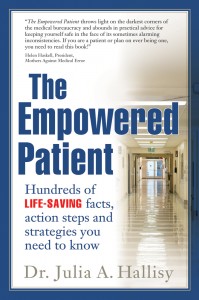One of my previous posts entitled “How To Keep Yourself Safe In A Hospital” provoked a great deal of response, both on and off this blog. I received a number of e-mails from individuals looking for more information. One person who responded to the blog was Dr. Julia Hallisy, an expert in the area of hospital acquired infections. Dr. Hallisy practices in California, and had her own very personal experience with hospital acquired infections. That story is too personal for me to attempt to summarize, but interested readers can learn more at Dr. Hallisy’s website www.TheEmpoweredPatient.com. Dr. Hallisy’s website can also be accessed from our blogroll.
provoked a great deal of response, both on and off this blog. I received a number of e-mails from individuals looking for more information. One person who responded to the blog was Dr. Julia Hallisy, an expert in the area of hospital acquired infections. Dr. Hallisy practices in California, and had her own very personal experience with hospital acquired infections. That story is too personal for me to attempt to summarize, but interested readers can learn more at Dr. Hallisy’s website www.TheEmpoweredPatient.com. Dr. Hallisy’s website can also be accessed from our blogroll.
Suffice it to say that since Dr. Hallisy’s experience, she has dedicated her time to informing patients of their right to demand their doctors, nurses and hospital staff abide by rules and regulations designed to minimize the risk of infection.
To satisfy your requests for additional information, I asked Dr. Hallisy if she would be willing to write a guest post for our readers, and she graciously accepted. Without further introduction, here is Dr. Hallisy’s post:
I’m often asked if patients and their advocates can really translate information and facts into the practical skills they need to avoid medical errors. I know that the answer to this question is a resounding “yes” because I envision a health care system where patients know that they can check the Health & Human Services website www.hospitalcompare.hhs.gov to become familiar with “process of care measures” utilized at the hospitals in their region. These measures include care standards for several high-risk conditions including heart attacks, heart failure, pneumonia and surgical site infections. Printing a list of the protocols to take to the hospital with you may be the difference between receiving all the care appropriate for your condition and having important treatment options overlooked. This is not the most user-friendly website, but work your way through it until you find the lists of recommendations for each condition.
Studying the Hospital Compare lists will help ensure that aspirin and beta blockers are given to heart patients where indicated, which is especially important since congestive heart failure is a chronic disease that consumes over 50 percent of our health care dollars. The public can act as a resource to guarantee that antibiotics, blood cultures and vaccines are utilized as indicated in pneumonia patients. Surgical patients will learn that they can reduce their risk of infection and other complications by asking that their pre-operative antibiotics be given within one hour of the start of their surgery, by questioning their nurse if antibiotics are not stopped within 24 hours after their surgery and by inquiring if they need medication to prevent blood clots.
While surgical mishaps are not a common occurrence, they do happen. Patients need to know that the Joint Commission standards now include having surgeons mark the patient’s surgical sites with their initials prior to the start of surgery. An additional measure of protection is the “time-out” process in the operating room. The surgical team should stop for a final confirmation that they have the right patient, the correct body part and the correct x-rays or scans present. You will likely be asleep for this step, but be sure to ask both your doctor and the surgical staff in advance to take their “time out.”
With the Centers for Disease Control and Prevention website reporting that 1.7 million Americans will suffer each year from a hospital-acquired infection and that 99,000 people will die every year from these infections, it becomes vital for patients to be proactive and state their expectations about hand washing, the use of gloves and the wiping of the flat end of stethoscopes with alcohol long before they are touched by a health care provider. We can all help in the fight against infection by realizing that antibiotics are serious medications that should be used with care. We must change our mindset concerning antibiotic use immediately and patients need to understand that antibiotics are never effective against viruses and that newer research shows that many common conditions such as bronchitis are often viral and do not warrant a prescription.
Caring for and curing our bodies will always be inherently risky. That fact is undeniable. What I can promise you is that the advice and actions listed above represent only a fraction of the resources available to patients to help them stay safe in our medical system. They are realistic, achievable and could very well save your life or the life of someone you love.
Dr. Julia Hallisy is a general dentist practicing in San Francisco, California. She is the author of “The Empowered Patient: Hundreds of life-saving facts, action steps and strategies you need to know.” Visit her website at www.TheEmpoweredPatient.com.
Thanks for reading,
ZiffLaw Attorney, Esq.
New York and Pennsylvania Personal Injury and Malpractice Attorney
Ziff, Weiermiller, Hayden & Mustico, LLP
303 William Street
Elmira, NY 14901
Phone: (607)733-8866
Fax: (607)732-6062
Email: info@zifflaw.com
www.zifflaw.com

.jpg)




